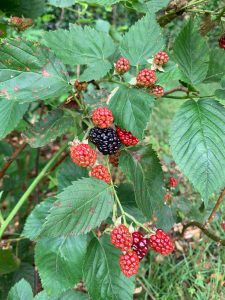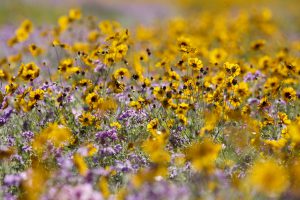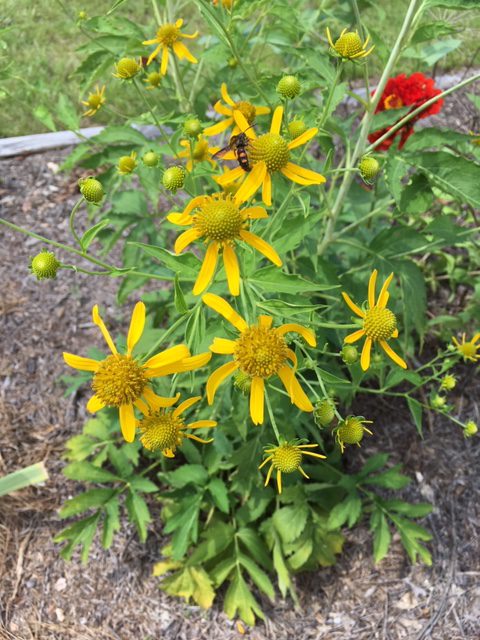

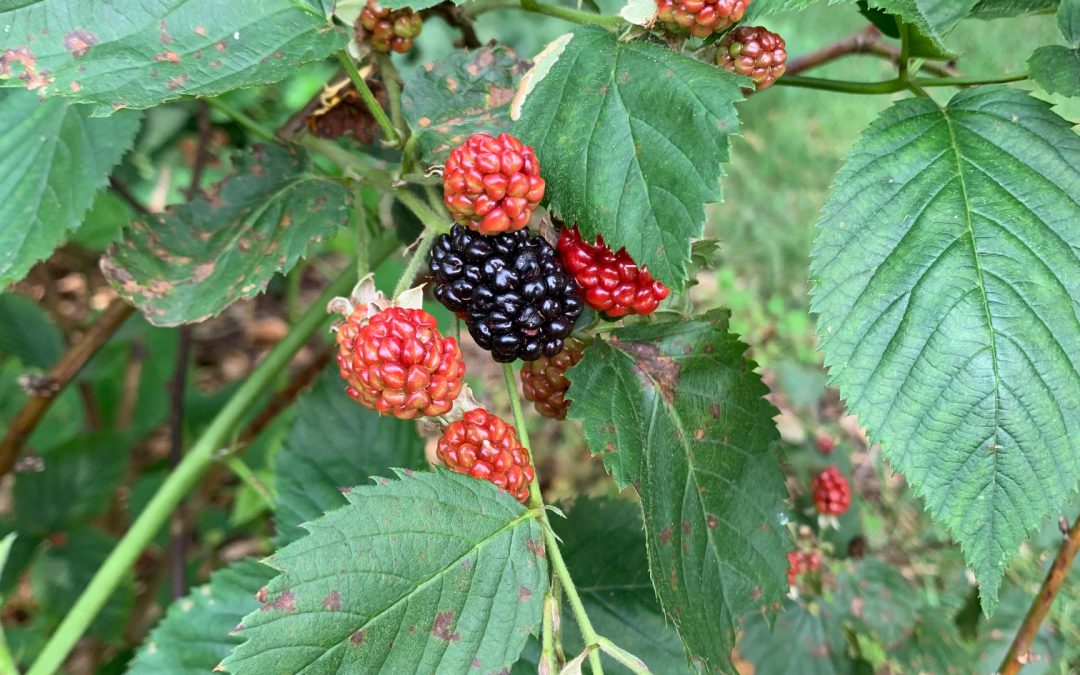
Time to Harvest Blackberries!
To everyone’s delight, the blackberries are ripening in the Santa Rosa County Extension demonstration garden. The blackberry patch is a reliable perennial that continues to provide fresh berries year after year. Before you decide against them because you don’t want a thorny and painful hazard in your landscape, remember that there are thornless blackberry cultivars with fruit just as tasty as the old-fashioned thorny blackberry varieties. However, it is important to take care and make sure that the variety or cultivar you choose is adapted to our Florida climate and chill hours.
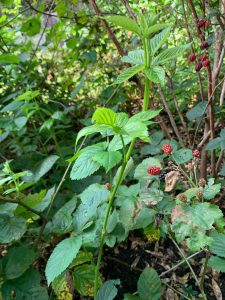
Blackberries bloom and produce fruit on last year’s canes. This year’s growth (the bright green shoot in the front center) will produce next year. Photo credit: Mary Salinas, UF/IFAS Extension.
You can choose a blackberry variety from your local nursery or propagate some plants from a favorite blackberry grown by a friend or neighbor (with permission, of course). Methods of propagation include stem cuttings, root cuttings, tip layering and removing the suckers that arise from the roots.
Plant when the weather is cooler in winter and choose a sunny spot with good soil. Frequent irrigation is crucial during the establishment period and when the fruit is produced. Weed control with organic or plastic mulches is also important to the success of your blackberry patch.
For more information on blackberry cultivars, propagation and growing success please see the University of Florida publication The Blackberry.
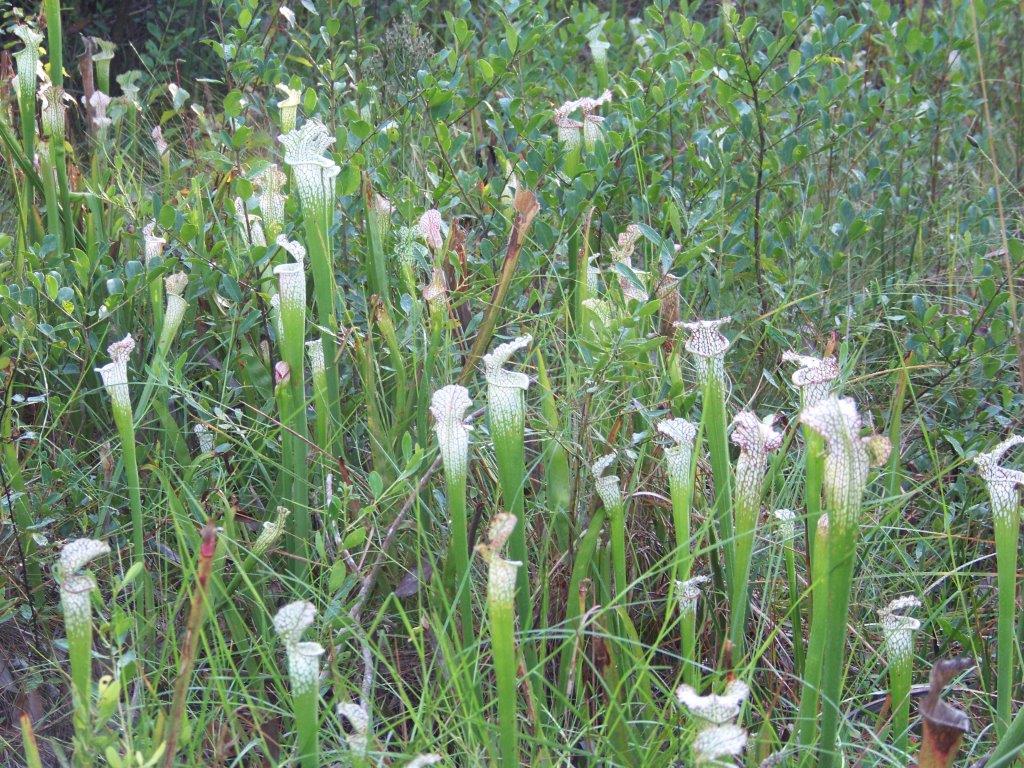
Roadside Wildflower Areas Provide Beauty for Travelers
Florida (“land of flowers” in Spanish) is and has always been full of flowers, and countless civic and public organizations work diligently to protect and promote the beauty of our natural ecosystems. Did you know that the Florida Wildflower Foundation works with the Florida Department of Transportation (FDOT) to preserve wildflower areas on state-maintained roads throughout Florida? This effort really took off in the 1960’s when non-native Crimson clover started sprouting among sod planted by the state FDOT, and has grown into a much larger statewide initiative. The state wildflower license plate program provides funding for these efforts.
Wildflower areas along highways not only improve beauty on the roadsides, but provide habitat for countless pollinator insects that drive our $1.2 billion (annual) citrus and agricultural industries and our own backyard landscapes. In addition, leaving no-mow areas along highways saves money on mowing costs, reduces soil erosion, and improves air quality.
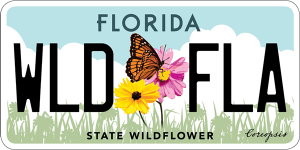
The state wildflower license plate supports wildflower preservation efforts statewide. Photo credit: Florida Wildflower Foundation
Wildflower viewing is typically best in the spring and fall, and particularly in areas (such as state parks and forests) that have been recently managed by prescribed fire. Many low-lying areas are home to beautiful native species such as pitcher plants, hibiscus, and meadowbeauty. Be very careful when viewing or stopping to see roadside wildflowers, and be sure to find designated parking areas to prevent accidents. To find a map of the wildflower trails, visit your local tourism bureau or go online at https://flawildflowers.org/protect/.
Currently, every Panhandle county from Jefferson County east has designated wildflower areas. The Escambia County Board of Commissioners passed a wildflower ordinance supporting the program, and a committee met in May 2019 to determine more areas of the county appropriate to set aside for the program. As opposed to planting new wildflowers, the program prioritizes conserving roadside areas that already support healthy wildflower populations. If you know of good candidates for preservation on state roads in Escambia or any other panhandle county, please contact me (ctsteven@ufl.edu) or Liz Sparks (liz.aparks57@gmail.com) with the Florida Wildflower Foundation.
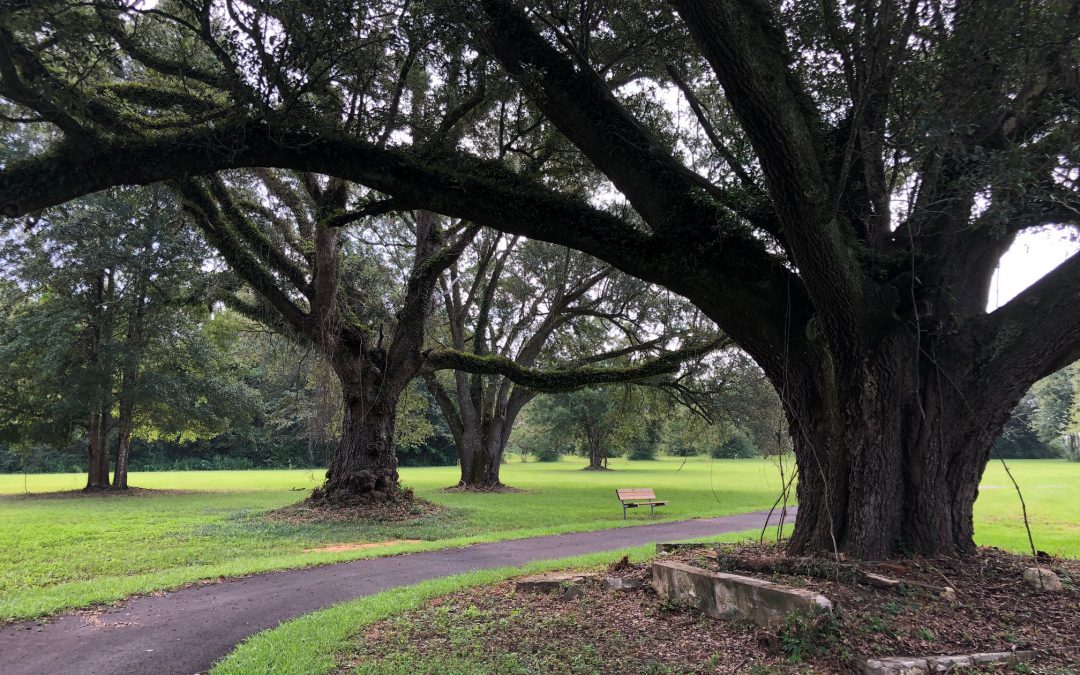
New Tree Identification Trail to Provide Knowledge in the Shade
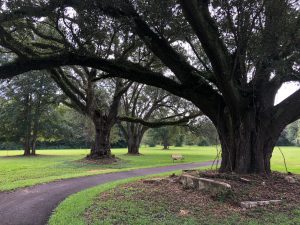
Historic live oaks provide shade and wildlife habitat at the Escambia Extension walking trail. Photo credit: Carrie Stevenson, UF / IFAS Extension
A recent study of 3-5 year olds found that the average pre-reading American child could identify hundreds of marketing brand logos (McDonald’s, Disney, even Toyota). Most researchers would be mightily challenged to find even a middle school student who can identify more than a couple of trees growing in their own backyard. The fields and forests many of us grew up in are steadily converting to look-alike suburban areas, so this lack of local natural knowledge is commonplace. As the quote by Senegalese forester Baba Dioum goes, “In the end, we will conserve only what we love; we will love only what we understand and we will understand only what we are taught.” If kids and adults do not appreciate and understand the natural world around them, we are unlikely to preserve these priceless wonders.
To do our part towards this aim of educating others, we at Escambia Extension received a grant from International Paper to plant 30 trees around our office’s walking track. Every tree has a clearly marked identification tag listing its common and botanical name.
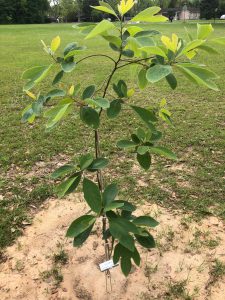
A newly planted sassafras tree on the Extension walking trail. Photo credit: Carrie Stevenson, UF / IFAS Extension
Initially we just planned to add more shade trees to the sunny side of the track, but after a discussion with local foresters, we realized this effort could be an ideal teaching tool. The local middle and high school Future Farmers of America (FFA) chapters participate in a tree identification contest, and are tasked with knowing 50 native tree species. While 10 of them were tropical species that do not perform well in north Florida, we have the other 40 planted here on the property. Students and any interested citizen interested in learning these native species can walk along our track, getting exercise and taking in the natural world around them.
A spring walking event will kick off the official opening of the tree identification trail, so join us April 26 to learn more about healthy living and the value of trees. Or, join us for an Extension Open House on April 27 to explore the demonstration gardens, purchase vegetable plants, or learn more about Extension’s wide array of community services.
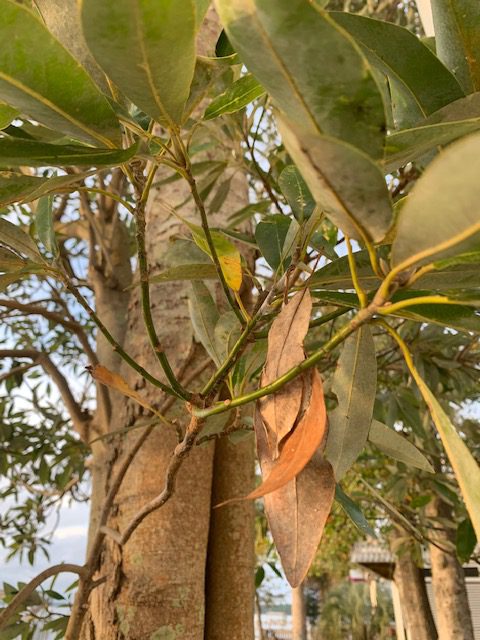
An Unexpected Inhabitant
You never know what you’ll find when you start looking closely in your garden. I was puzzled as to why there were three dead leaves hanging together on my sweetbay tree when all the other leaves looked so nice and healthy. On further investigation, I found a cocoon was made by binding the leaves together and it was firmly attached to the branch with silk.
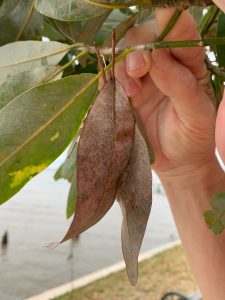
The hanging dead leaves are a perfect hiding place for the cocoon of the sweetbay silkmoth. Photo credit: Mary Salinas.
This is the cocoon of the Sweetbay silkmoth, Callosamia securifera. Adult females lay their eggs on the native sweetbay tree, Magnolia virginiana, as the caterpillars only feed on sweetbay leaves. The trees tolerate having a few leaves eaten so there is no need to pick off the caterpillars if you find them. Local birds may do that for you as they rely on an abundance of caterpillars to feed their baby birds.
See photos of this beautiful moth with more details on its life cycle.
And then explore Gardening with Wildlife on UF/IFAS Gardening Solutions.
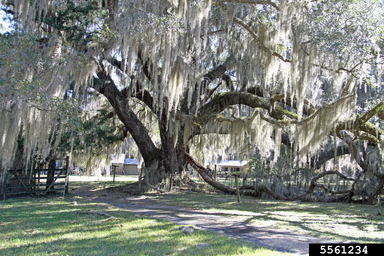
Importance of Native Plants for Wildlife

Native trees, like this Live Oak (Quercus virginiana), provide habitat for various insects fed upon by birds. Source: James Holland, Bugwood.org
Planting native plants is a topic many north Florida gardeners, and subscribers to Gardening in the Panhandle, have seen covered in various ways and formats. It doesn’t take a great leap of understanding to realize that native plants are highly valued by our wildlife, which have adapted to living with these plants for millennia. However, we also get a lot of information about the latest, greatest landscape plant variety, many of which are non-native, and are lured to purchase them by their beautiful flowers and/or foliage. In the wake of Hurricane Michael, the importance of selecting native plants for the landscape becomes apparent when you look around and see whole forests severely disturbed. Furthermore, recent research has shown how much our native wildlife prefer native plants and need them for the best chances of survival.
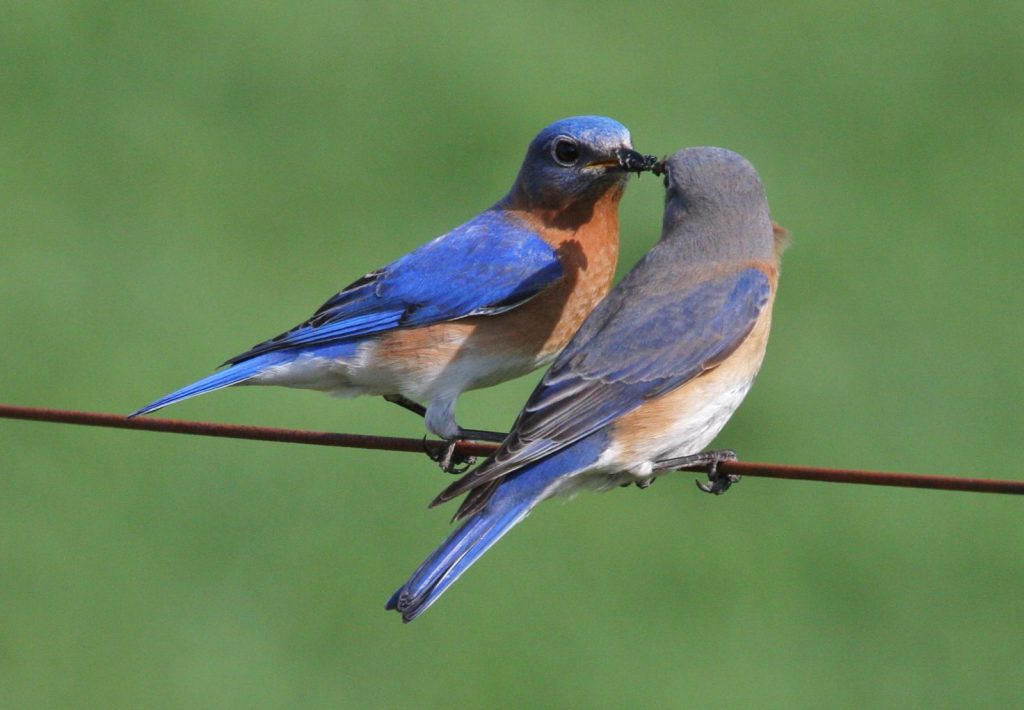
Eastern bluebirds are an example of a bird that relies on insects. Source: Sandysphotos, Creative Commons.
Why Native Plants?
It’s not that non-native ornamental plants are “bad”, unless they’re the terrible invasive, exotic species like kudzu, Chine privet, etc., it’s just that the food chains that support our wildlife are adapted to native plants. A recent report published in the National Proceedings of Science found that chickadees had far better success fledging young when they foraged landscape areas containing 70% or more native plant cover. The reason for their success was that the insects they feed on utilize native species more than non-native plant species. Does that mean non-natives provide no value? Not necessarily. Non-native ornamental plants can be important sources of nectar and pollen and, as you know from experience dealing with pest problems on non-native plants, they also support insects. Native plants just support more of an abundance of these insects.
Following a large disturbance like Hurricane Michael, many insects, birds, and other wildlife will likely see a decrease in numbers and/or reproductive success due to the loss and/or disruption of native plant ecosystems. As stated in the recent report, restoration of urban areas should prioritize native plants to support local food webs.
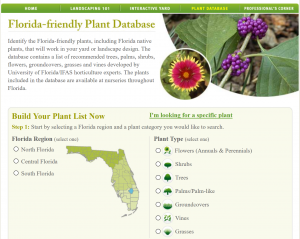
The deactivated_site website is a great resource to find native trees for your area. Source: Screenshot, deactivated_site.
The deactivated_site website is an easy way to start putting together a list of potential plants. The website’s Florida-Friendly Plant Database allows users to select the area of Florida they live in, site conditions, plant type (tree, shrub, etc.), and to specify native plants only. It then searches the database for plants that meet those conditions and creates a list of species, along with photos and care information. If you’re thinking about how these trees hold up to storms, you can cross-check that list with UF/IFAS’s Wind and Trees EDIS publication. Of course, if you have any questions along the way, please contact your local UF/IFAS Extension Office.

